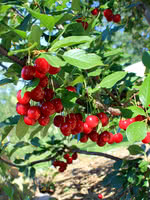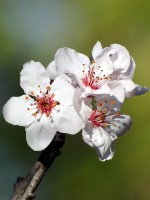Mon-Fri 9am - 5pm Mountain time
Evans Cherry vs Western Sand Cherry
Prunus cerasus Evans
Prunus pumila var besseyi
NOT AVAILABLE THIS SEASON - MIGHT RETURN
Evans Cherry is a cold-hardy sour cherry tree that is typically highly productive. It produces bright red, tart fruit that are well suited to fresh eating, baking, and preserves. In the spring, beautiful white flowers cover the branches, adding ornamental value.
Evans Cherry was developed in Alberta. It was rediscovered in 1976 near Edmonton, AB, by Dr. Ieuan Evans.
Sour cherries are self-fertile; however, planting with additional varieties for cross-pollination can increase yields.
Western Sand Cherry is known for its unique, leathery grey-green foliage and beautiful white blossoms. It is a popular ornamental shrub in parks and front yards. Both you and the wildlife will love its edible small dark red to purple cherries.
Due to its small stature and spreading qualities, Western Sandcherry is suitable as an underplanting or groundcover.
Many people graft plum and cherry varieties to Western Sand Cherry and use it as rootstock. It is also popular to graft hardy apricots to.

